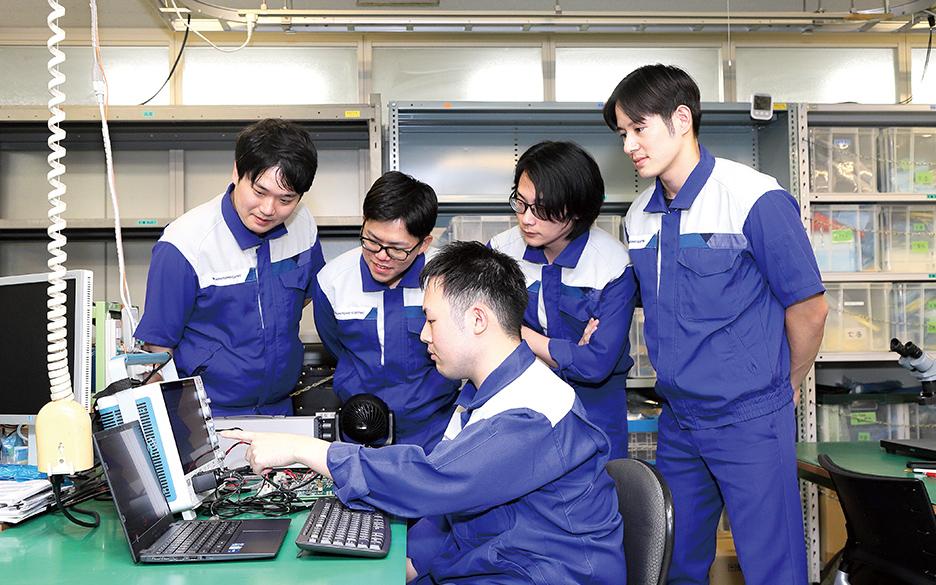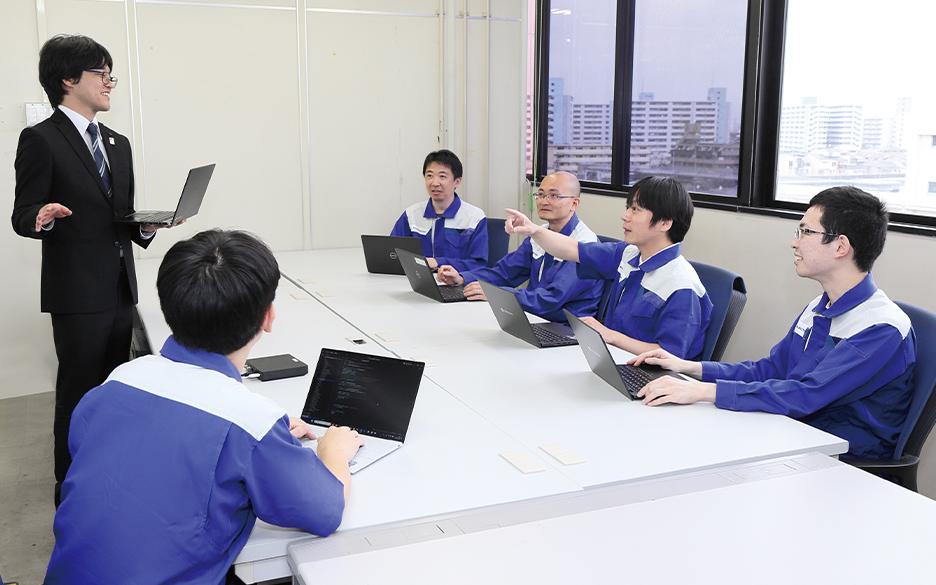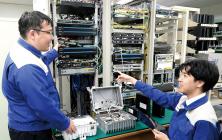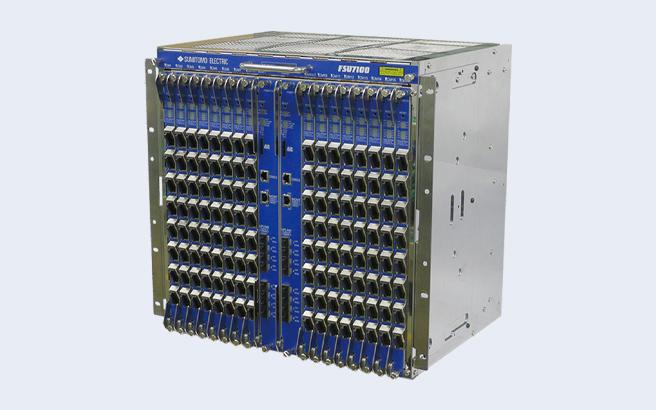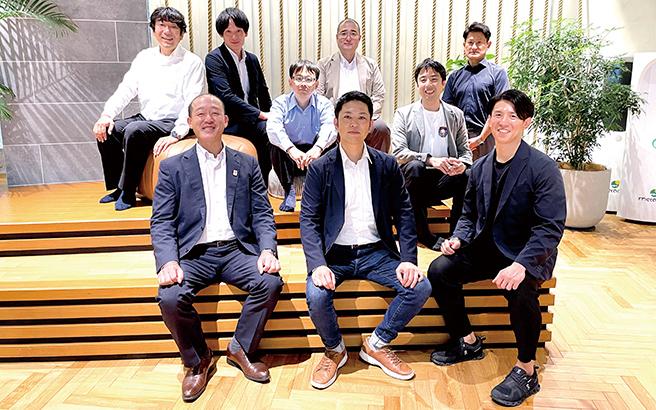
At the Forefront of Broadband
Energy Efficiency of OLTs, Expanding Demand for STBs, and Innovations in Networks for CATV
Initiatives to reduce power consumption -Network Products Department
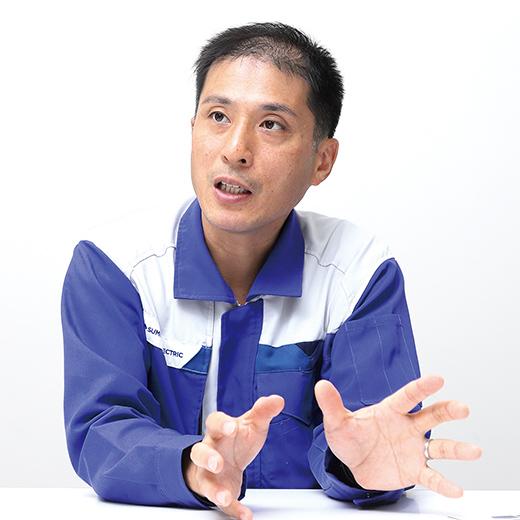
The Network Products Department is currently focusing on reducing the power consumption of its equipment to help achieve carbon neutrality. FTTH, which connects every home with optical fiber, is already the mainstream in broadband service, but it involves a large number of installed devices that are always powered on, which presents significant potential for significant energy savings through power-saving measures. The flagship product targeted for power savings is the 10G-EPON OLT. Naoki Yoshitani, Manager of the 1st Hardware Development Group, has been working on equipment development as an OLT hardware engineer alongside the evolution of broadband networks.
“In developing a new energy-efficient OLT, we are working to reduce the size of OLTs for large urban stations by 50% or more, facilitating service expansion to smaller stations. A key factor in reducing power consumption is the scaling down of semiconductor chip features. This scaling allows for a lower voltage applied to internal transistors, leading to lower power consumption. We are working with vendors to implement advanced chips,” said Yoshitani.
Furthermore, additional power savings will be achieved by redesigning the device structure and enhancing operational and cooling techniques. Various initiatives are being conducted in preparation for the release of a power-saving OLT, including the use of ICs (FPGAs*1) that allow for flexible configuration to implement various functions as core components.
“We will continue to work on power conservation to contribute to our customers’ carbon neutrality and to the realization of the green society that our group envisions,” said Yoshitani.
Our own developed entry-level STB -Video Products Department

Hajime Iseki, Manager of the 2nd Software Development Group, has been in charge of STB software development since joining the company. The company’s proprietary common platform, stbcore™, is middleware designed to provide the essential functions required for STBs, such as broadcast reception, recording and playback, and content distribution to mobile devices. By enhancing the compatibility of systems and services, it achieves these functions while also shortening STB development time and ensuring high quality.
“An outcome of stbcore™ is our BS4K-compatible entry-level STB, which we launched in December 2023. Compared to current models, this model is specialized for watching and recording programs to achieve lower costs. Equipped with two tuners, the STB allows users to watch one program while recording another. We designed the user interface (UI), which directly influences user operability. We aimed to develop such a simple, easy-to-use, and quick-response UI that even first-time STB users would feel comfortable using,” said Iseki.

Hiroaki Konishi of the 2nd Technical Marketing Group emphasized the products we developed. As a sales technical representative, Konishi is responsible for negotiating with telecommunications carriers and for product development and launch.
“We have taken into account customer requests, but fundamentally it is a model that we have developed. In particular, the UI embodies our ideas. The challenge was to maintain high quality while also making it easy to use and keeping costs low. Going forward, taking advantage of the fact that approximately two million units, including those sold so far, have been installed in end users’ homes, we would like to explore new services that fit the lifestyles of our users,” said Konishi.
This model has been designed to accommodate the transition from B-CAS (C-CAS) cards inserted into televisions to ACAS chips integrated directly into televisions or STBs, and it is expected to generate substantial upgrade demand as it is an ACAS-compatible STB.
Shift to distributed networks -CATV Systems Department

The Internet services offered by CATV operators include a system that communicates over HFC using CMTS*2 devices installed within the station’s premises (center) and cable modem terminals installed in the subscribers’ homes. In response to the growing demand for high-speed communication services, CATV operators are being forced to deal with the expensive installation and maintenance costs of CMTS devices, as well as the increased installation space and power consumption. One of the CATV Systems Department’s missions is to provide solutions to these issues. Makoto Ito, Manager of the Communication Systems Development Group, pointed out that the key to tackling these issues is moving away from reliance on CMTS.
“We are working with Harmonic Inc. to propose a shift to a distributed network configuration called DAA. DAA reduces the load on the center facilities by installing some of the CMTS functions as an R-PHY unit on the pole-mounted transmission equipment, which also saves space and power,” said Ito.
Another feature is that by virtualizing the CMTS and managing it on a server, significant cost reductions and energy savings can be expected. In addition, to meet the demand for higher-speed services, the network can be upgraded to photonics by simply replacing R-PHY units with R-OLT units. DAA allows for photonics deployment to apartment complexes and a gradual transition in line with the expansion stage of FTTH.
“By distributing, virtualizing, and transitioning to a photonic architecture, we aim to solve issues faced by CATV operators and contribute to the evolution of cable networks,” said Ito.
*1: Field-Programmable Gate Array: a programmable IC that integrates logic circuits and can realize a variety of functions by changing the internal circuit configuration depending on the application.
*2: Cable Modem Termination System: a device installed in a CATV center to provide Internet services via CATV lines.
NEXT
Developing New Technology to Pave the Way to the Future of Broadband
- All-Photonics Network for High-Speed, High-Capacity, Low-Latency, and Low-Power Consumption -
Registration of public notification
If you register your e-mail address, we will notify you when the latest issue is published. If you wish, please register from the registration form.
To delete your registration, please visit here.
